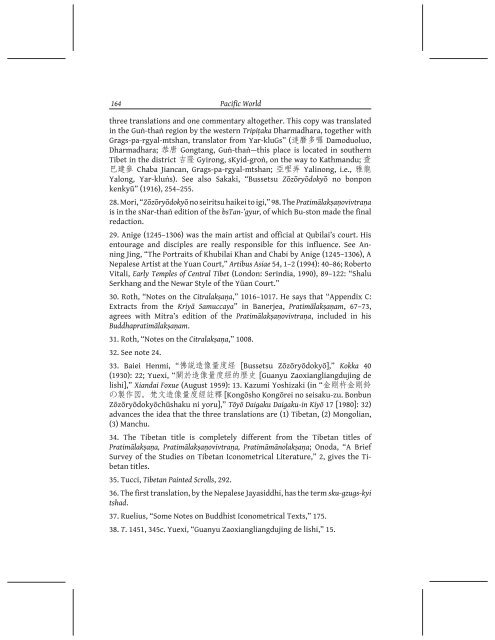download - The Institute of Buddhist Studies
download - The Institute of Buddhist Studies
download - The Institute of Buddhist Studies
You also want an ePaper? Increase the reach of your titles
YUMPU automatically turns print PDFs into web optimized ePapers that Google loves.
164<br />
Pacific World<br />
three translations and one commentary altogether. This copy was translated<br />
in the Guṅ-thaṅ region by the western Tripiṭaka Dharmadhara, together with<br />
Grags-pa-rgyal-mtshan, translator from Yar-kluGs” ( 達 磨 多 囉 Damoduoluo,<br />
Dharmadhara; 恭 唐 Gongtang, Guṅ-thaṅ—this place is located in southern<br />
Tibet in the district 吉 隆 Gyirong, sKyid-groṅ, on the way to Kathmandu; 查<br />
巴 建 參 Chaba Jiancan, Grags-pa-rgyal-mtshan; 亞 哩 弄 Yalinong, i.e., 雅 龍<br />
Yalong, Yar-kluṅs). See also Sakaki, “Bussetsu Zōzōryōdokyō no bonpon<br />
kenkyū” (1916), 254–255.<br />
28. Mori, “Zōzōryōdokyō no seiritsu haikei to igi,” 98. <strong>The</strong> Pratimālakṣaṇovivtraṇa<br />
is in the sNar-thaṅ edition <strong>of</strong> the bsTan-’gyur, <strong>of</strong> which Bu-ston made the final<br />
redaction.<br />
29. Anige (1245–1306) was the main artist and <strong>of</strong>ficial at Qubilai’s court. His<br />
entourage and disciples are really responsible for this influence. See Anning<br />
Jing, “<strong>The</strong> Portraits <strong>of</strong> Khubilai Khan and Chabi by Anige (1245–1306), A<br />
Nepalese Artist at the Yuan Court,” Artibus Asiae 54, 1–2 (1994): 40–86; Roberto<br />
Vitali, Early Temples <strong>of</strong> Central Tibet (London: Serindia, 1990), 89–122: “Shalu<br />
Serkhang and the Newar Style <strong>of</strong> the Yüan Court.”<br />
30. Roth, “Notes on the Citralakṣaṇa,” 1016–1017. He says that “Appendix C:<br />
Extracts from the Kriyā Samuccaya” in Banerjea, Pratimālakṣaṇam, 67–73,<br />
agrees with Mitra’s edition <strong>of</strong> the Pratimālakṣaṇovivtraṇa, included in his<br />
Buddhapratimālakṣaṇam.<br />
31. Roth, “Notes on the Citralakṣaṇa,” 1008.<br />
32. See note 24.<br />
33. Baiei Henmi, “ 佛 説 造 像 量 度 経 [Bussetsu Zōzōryōdokyō],” Kokka 40<br />
(1930): 22; Yuexi, “ 關 於 造 像 量 度 經 的 歷 史 [Guanyu Zaoxiangliangdujing de<br />
lishi],” Xiandai Foxue (August 1959): 13. Kazumi Yoshizaki (in “ 金 剛 杵 金 剛 鈴<br />
の 製 作 図 。 梵 文 造 像 量 度 經 註 釋 [Kongōsho Kongōrei no seisaku-zu. Bonbun<br />
Zōzōryōdokyōchūshaku ni yoru],” Tōyō Daigaku Daigaku-in Kiyō 17 [1980]: 32)<br />
advances the idea that the three translations are (1) Tibetan, (2) Mongolian,<br />
(3) Manchu.<br />
34. <strong>The</strong> Tibetan title is completely different from the Tibetan titles <strong>of</strong><br />
Pratimālakṣaṇa, Pratimālakṣaṇovivtraṇa, Pratimāmānolakṣaṇa; Onoda, “A Brief<br />
Survey <strong>of</strong> the <strong>Studies</strong> on Tibetan Iconometrical Literature,” 2, gives the Tibetan<br />
titles.<br />
35. Tucci, Tibetan Painted Scrolls, 292.<br />
36. <strong>The</strong> first translation, by the Nepalese Jayasiddhi, has the term sku-gzugs-kyi<br />
tshad.<br />
37. Ruelius, “Some Notes on <strong>Buddhist</strong> Iconometrical Texts,” 175.<br />
38. T. 1451, 345c. Yuexi, “Guanyu Zaoxiangliangdujing de lishi,” 15.
















